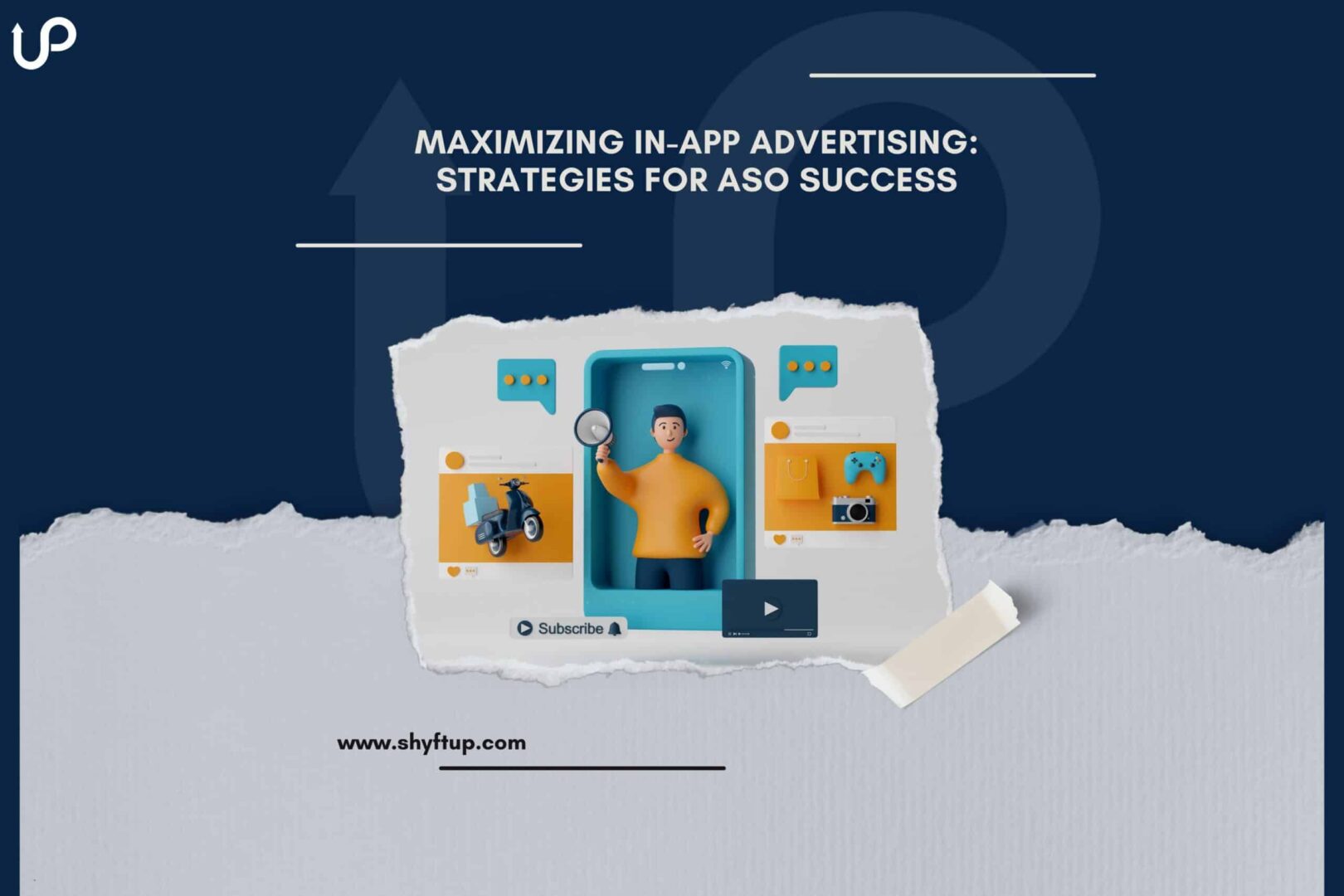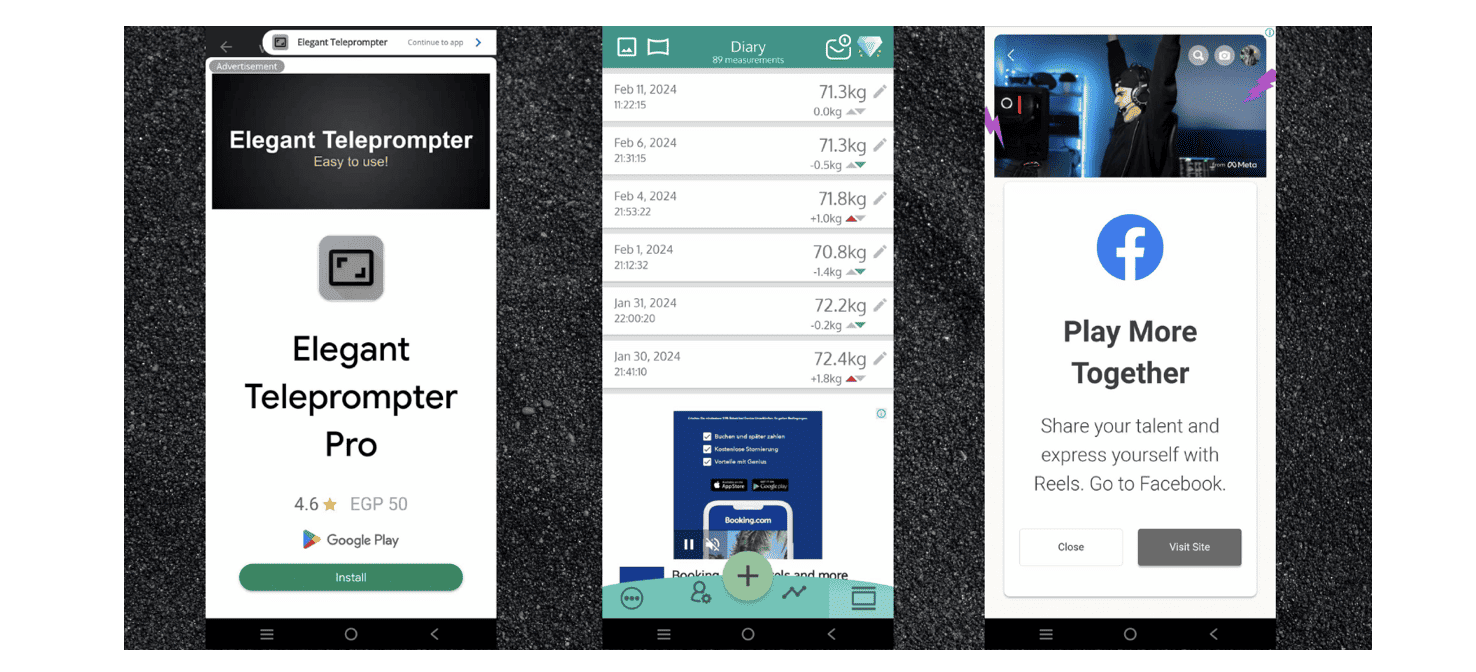
In-app advertising stands out as one of the most effective means for monetizing your mobile app. By permitting other companies to display ads within your app in exchange for fees, you have the potential to significantly boost your revenue, particularly when your user base is substantial.
However, effectively managing in-app ads entails employing various strategies to ensure you unlock their full earning potential. Among the most effective approaches is leveraging ASO (App Store Optimization) strategies to maximize your earnings from in-app advertising.
In this blog post, you’ll delve into how ASO can be utilized to enhance your revenue from in-app advertising. Keep reading to uncover invaluable tips for enhancing your app’s success!
What is In-App Advertising?
In-app advertising refers to the practice of displaying advertisements within a mobile application (app). These ads can take various forms, such as banners, interstitials, native ads, rewarded videos, and more. In-app advertising allows app developers to generate revenue by partnering with advertisers who pay to have their ads shown to users while they are using the app.
In-app ads can be targeted based on various factors such as user demographics, interests, behavior, and location, making them more relevant and engaging for users. This targeted approach often results in higher click-through rates and better return on investment for advertisers.
For app developers, in-app advertising offers a monetization strategy that can complement or replace other revenue streams such as in-app purchases or subscription fees. By integrating ad networks or partnering directly with advertisers, developers can earn revenue based on metrics such as ad impressions, clicks, or conversions.
What is App Store Optimization (ASO)?
App Store Optimization (ASO) is the process of improving the visibility and discoverability of your app in app stores. In essence, the more visible your app and the higher its ranking, the greater your chance of getting more downloads and users.
There are different ways for you to perform effective ASO, which include keyword optimization, crafting persuasive app descriptions, using high-quality visual assets, utilizing localized content, encouraging positive reviews and ratings, and regularly updating and maintaining your app.
How to use ASO in Improving In-App Advertising?
ASO strategies can play a crucial role in improving your in-app advertising efforts by increasing app visibility, driving more downloads, and enhancing user engagement. Remember, you earn more from in-app ads when you have more users. The more people who are using your app, the more people who will see the ads, creating more earning opportunities for you.
With this in mind, you can maximize your profit with in-app advertising with the following ASO strategies:
1. Keyword Optimization for Discoverability
Keyword optimization is a critical aspect of ASO that involves strategically integrating relevant keywords into various elements of your app’s listing to improve its visibility and discoverability in app store search results.
Here’s a more detailed explanation of how you can effectively optimize keywords for discoverability in the context of in-app advertising:
Select Relevant Keywords
Start by researching and selecting keywords that are closely related to in-app advertising, ad-supported content, and relevant topics within your app’s niche. Consider terms that users are likely to search for when looking for apps that offer ad-supported features or opportunities to engage with ads.
Incorporate Keywords in the App Title
The app title is one of the most weighted elements in app store algorithms, so include your primary keywords prominently within it. Ensure that the title remains concise, descriptive, and engaging while incorporating relevant keywords to improve search visibility.
Optimize App Description
Craft a detailed and informative app description that incorporates relevant keywords naturally throughout the text. Highlight the benefits of in-app advertising within the description while seamlessly integrating targeted keywords to improve search rankings and attract users interested in ad-supported content.
Utilize Keywords in Metadata
Incorporate targeted keywords into the app’s metadata, including the keyword field and any relevant tags or categories. This metadata provides additional context to app store algorithms, helping them understand the relevance of your app to users searching for specific terms related to in-app advertising.
Regularly Monitor and Update Keywords
Stay proactive by monitoring the performance of your selected keywords and making adjustments as needed based on changes in user behavior, market trends, or competitor strategies. Continuously optimizing your keyword strategy will help maintain and improve your app’s search visibility over time.
Avoid Keyword Stuffing
While it’s essential to incorporate relevant keywords into your app’s listing, avoid overloading it with excessive keywords in an attempt to manipulate search rankings. Keyword stuffing can negatively impact user experience and may result in penalties from app store algorithms. Focus on providing valuable and relevant content that resonates with users while incorporating keywords naturally.
By effectively optimizing keywords related to in-app advertising within your app’s title, description, and metadata, you can significantly enhance its discoverability and attract users interested in engaging with ad-supported content. This, in turn, can lead to increased app downloads, higher ad impressions, and ultimately, greater revenue from in-app advertising.
2. Highlight Ad Monetization Benefits
Craft a compelling app description that clearly communicates the benefits of in-app advertising for your users. Obviously, some people don’t like ads but they can tolerate them if you explain to them the reason for the ads. Here are a few things you can do to minimize the negative effects of running ads:
Emphasize Free Content
Communicate to users that by engaging with in-app ads, they can access your app’s content for free. Highlight the value proposition of enjoying high-quality content without having to pay for subscriptions or in-app purchases.
Showcase Rewards and Incentives
Mention any rewards, incentives, or benefits that users can receive through ad engagement. This could include virtual currency, bonus items, exclusive discounts, or access to premium features. Clearly outline how users can benefit from interacting with ads within your app.
Stress User Control and Experience
Assure users that their ad experience is designed to be non-intrusive and respectful of their preferences. Highlight any features or options that allow users to control the frequency or type of ads they see, ensuring a positive and personalized experience.
By crafting a compelling app description that effectively communicates these benefits, you can attract users to your app’s ad-supported model. This can ultimately lead to increased user engagement, higher ad revenue, and a stronger position in the competitive app marketplace.
3. Optimize Visual Assets
When optimizing visual assets to maximize earnings from in-app advertising, it’s crucial to strike a balance between promoting the presence of ads and maintaining an attractive and cohesive visual aesthetic that resonates with users. Here’s a deeper dive into optimizing visual assets:
App Icon
The app icon is the first impression users have of your app, so it’s essential to design one that not only represents your brand but also communicates the presence of in-app advertising. You can subtly integrate visual elements such as ad banners or icons that signify ad-supported content without overwhelming the overall design. For example, incorporating a small “Ad” label or symbol in the corner of the app icon can effectively convey the ad-supported model while maintaining visual appeal.
Screenshots
Screenshots play a significant role in showcasing your app’s features and benefits to potential users. When optimizing screenshots for in-app advertising, consider including visuals that highlight ad-supported content or interactions within the app. For instance, you can include screenshots of users engaging with ads to unlock rewards or access premium content.
Visual Consistency
Maintain visual consistency across all visual assets, including the app icon, screenshots, and promotional images. Use consistent branding elements, color schemes, and design styles to create a cohesive and recognizable visual identity for your app. This consistency helps reinforce brand recognition and trust among users while ensuring a seamless user experience.
User-Centric Design
Prioritize user experience and usability when designing visual assets for in-app advertising. Ensure that visuals are clear, engaging, and easy to comprehend, even at a glance. Consider user preferences, behavior, and feedback when refining visual designs to create a positive and memorable impression that encourages users to engage with your app’s ads.
By optimizing visual assets in this manner, you can effectively communicate the presence of in-app advertising while maintaining an attractive and user-friendly app experience. This approach helps maximize earnings from in-app advertising by enhancing user engagement, retention, and overall satisfaction.
4. Offer Ad-Related Incentives
Implement features or rewards within your app that incentivize users to engage with in-app advertising. For example, offer virtual currency, premium content, or exclusive discounts in exchange for watching ads or interacting with sponsored content.
5. Encourage Positive Reviews Related to Ads
Encouraging positive reviews related to ads involves actively prompting users to leave feedback specifically focused on their satisfaction with the in-app advertising experience. Here’s a more detailed explanation of this strategy:
Prompting Users for Reviews
Implement in-app prompts or notifications asking users to rate and review their experience with the app’s in-app advertising. Timing is crucial here, so consider strategic moments such as after a user completes an interaction with an ad or achieves a milestone within the app.
Highlighting Benefits and Incentives
Emphasize the benefits, rewards, or incentives that users receive from engaging with in-app ads. For example, if users earn virtual currency, unlock premium content, or receive exclusive discounts by interacting with ads, make sure to highlight these perks when prompting for reviews.
Providing Clear Instructions
Make it easy for users to leave feedback by providing clear instructions on how to do so within the app. Direct users to the app store review section or provide a convenient in-app form where they can share their thoughts about the ad experience.
By actively encouraging positive reviews related to in-app ads and highlighting the benefits and incentives associated with ad engagement, you can foster a more positive perception of in-app advertising among users, ultimately leading to higher ratings, increased user satisfaction, and improved overall app success.
6. Localized Ad Campaigns
Localized ad campaigns involve customizing advertising content, offers, and messaging to resonate with users in specific geographic regions or cultural demographics. This strategy recognizes that different markets may have unique preferences, interests, and cultural nuances that influence how they respond to advertising.
Here’s how you can implement localized ad campaigns using ASO techniques:
Market Research
Start by conducting thorough market research to understand the cultural, linguistic, and behavioral differences among your target audiences in different regions. Identify key demographics, interests, and preferences that can inform your localized ad campaigns.
Localized Content
Tailor ad content, offers, and messaging to align with the preferences and expectations of users in each target market. This may involve translating ad copy into local languages, incorporating culturally relevant imagery or references, and adapting offers to suit regional preferences.
Cultural Sensitivity
Ensure that your ad content is culturally sensitive and respectful of local customs, traditions, and sensitivities. Avoid using language or imagery that may be offensive or misunderstood in certain cultures, and consider consulting with local experts or native speakers to ensure authenticity.
Overall, localized ad campaigns allow you to connect with users on a more personal and relevant level, increasing engagement, conversion rates, and ultimately, ad revenue. By leveraging ASO techniques to tailor your advertising efforts to the unique characteristics of each target market, you can maximize the impact of your in-app advertising campaigns and drive success in diverse global markets.
7. Regularly Update and Optimize Ad Integration
Continuously monitor the performance of in-app advertising placements and optimize their placement, frequency, and relevance based on user feedback and engagement metrics. Ensure that ads are seamlessly integrated into the user experience without detracting from app usability or causing irritation.
8. Monitor Competitors’ Ad Strategies
Keep track of competitors’ in-app advertising strategies and ad monetization models through competitive analysis. Identify emerging trends, successful approaches, and potential gaps in the market to refine your own ad strategy and maximize earnings.
Enhance Your In-App Advertising with ASO
In summary, maximizing earnings from in-app advertising demands a comprehensive approach that seamlessly integrates App Store Optimization (ASO) strategies. By implementing ASO techniques tailored specifically to in-app advertising, developers can amplify app visibility, draw in more users, and optimize ad revenue potential.
To truly ensure that you extract the utmost value from your in-app advertisements, it’s essential to seek assistance from ShyftUp. With their expertise, experience, and specialized tools, they can help you craft the perfect ASO strategies that complement your in-app ad revenue model.
So, if you’re ready to elevate your ASO and propel your app’s success to new heights, don’t hesitate to give ShyftUp a try today!
What is App Store Optimization (ASO)?
How to use ASO in Improving In-App Advertising?
1. Keyword Optimization for Discoverability
Incorporate Keywords in the App Title
Regularly Monitor and Update Keywords
2. Highlight Ad Monetization Benefits
Showcase Rewards and Incentives
Stress User Control and Experience
4. Offer Ad-Related Incentives
5. Encourage Positive Reviews Related to Ads
Highlighting Benefits and Incentives
7. Regularly Update and Optimize Ad Integration



